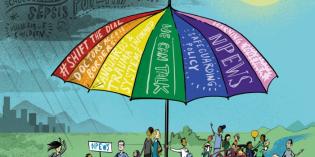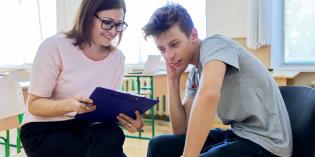These resources are related to the curriculum domain: 3 - Professional skills: procedures
What do children and young people say?
We asked for examples of when doctors have changed what they are doing to meet the needs of the patient. Children, young people and families shared their experiences:
- A young person with cerebral palsy and limited speech likes it when they are talked to directly and when the consultant emails before with questions and information.
- A child with epilepsy liked it when they got a copy of the brain scan which was drawn all over by the doctor to explain what happens.
- A young person said about how the doctor used easier words and did a drawing to explain what was going to happen.
- A parent shared how the doctor works with play specialists to use play, activities and role play to explain what will happen with the needle and when they have their procedure.
You can download our flyer with more CYP voices below.
Overview and teaching resource
Our presentation explains the procedures domain in more detail, and can be used as an overview or for a teaching session. You can download this presentation below.
A consultant's view - video
Make sure you know the procedure inside out... Do it with someone who wants you to succeed and makes you feel like you can succeed.
Dr Tessa Davis, Paediatric Emergency Medicine Consultant at the Royal London Hospital, talks about clinical procedures, and how to get them right.
Procedures in the neonatal unit - video
Dr Sian Harding, Neonatal consultant at University College Hospital London, talks about the skills and knowledge required to be good at procedures in neonatology.
Next, our case studies give examples of evidence that could be used to demonstrate contribution towards the domain learning outcome.
Leading a newborn resuscitation - case study
Role allocation and situational awareness are vital in leading a team approach to the management of clinical emergencies.
Setting: Labour Ward, Tertiary Level Hospital
How did the opportunity arise?
You are crash called to the Labour Ward as the on call registrar for NICU.
What happened?
A term baby is born in unexpectedly poor condition. You arrive with your team including a ST2, an ANNP and a neonatal nurse. You arrive to find the midwife initiating the Neonatal Life Support Algorithm. You decide to use the skills of the team and allocate roles.
As the most skilled person in managing neonatal airway, you secure the airway by endotracheal intubation. You delegate the ANNP to prepare for emergency umbilical venous line insertion, and you instruct your ST2 to perform CPR whilst the nurse is preparing medications and assisting with intubation. You ask one of the midwives to contact the consultant on call.
Once the airway is secured you are able to step back and maintain situational awareness and support your team in performing their tasks and delivering advanced neonatal resuscitation.
How did this support your development?
This is about leadership and optimising the skills of the multidisciplinary team. Understanding and utilising the skills of your team are important skills to learn as you progress through your training. Role allocation and situational awareness are vital in leading a team approach to the management of clinical emergencies. Supervising others and maintaining procedural competence are important skills at a more senior level of training.
Any practical tips?
Advanced neonatal life support courses help to prepare for the clinical and practical management of such situations. Regular simulation in the non-clinical environment can help to prepare for uncommon emergencies and development of non-technical skills including role allocation and situational awareness. Supervision during clinical emergencies can help you to develop non-technical skills.
The use of work-based placed assessments such as a Leader CBD is a useful way to reflect on these skills with a senior colleague.
Neonatal procedures - case study
A good understanding of the reasons for the procedures.. is crucial. Doing procedures with others at first helps this process
Setting: Neonatal unit – level 3
How did the opportunity arise?
You are the ST2 working on the SHO rota during your level 3 neonatal placement. A 28/40 baby is born by emergency caesarean section due to maternal sepsis, preterm labour and previous caesarean.
The neonatal team gathers, and you ask if you can do any procedures the baby might need. The baby is initially born in reasonable condition and transferred to the neonatal unit on CPAP. However, they quickly develop respiratory distress, and your SpR decides that the baby will need intubation, surfactant, and umbilical lines.
What happened?
On the unit, you prescribe the pre-medication and prepare for intubation, ensuring that you have all the necessary equipment and support. You successfully intubate on the first attempt with guidance and support from your senior. Surfactant is administered. You are less confident with umbilical lines, and your SpR scrubs with you. You insert a UVC and UAC with assistance.
You then document your procedures clearly and image to confirm correct placement.
How did this support your development?
Learning procedures needs ongoing training. Often this will start with observation of others performing these procedures, followed by seniors assisting you, before you are able to complete them independently.
A good understanding of the reasons for the procedures, and the relevant anatomy and physiology, is crucial. Doing procedures with others at first helps this process. Documentation also allows reassessment of the key steps in the procedure, and can be used as part of your personal procedure log.
Any practical tips?
Practice prior to these procedures, such as using teaching models, can help with technical skills and confidence. Starting with older/larger/more stable babies will also allow your skills to develop. Ensure you have supportive seniors around to assist and guide you in case any difficulties arise.
Paediatric resuscitation - case study
As you become more senior, you move to supervision of others in specific procedures... you need to feel comfortable with the procedure yourself, know your team well and know when you need to take over.
Setting: Paediatric A&E, DGH
How did the opportunity arise?
An 18 month old boy presents as a blue call by ambulance with reduced consciousness. The team gathers with yourself leading. You perform an initial assessment and brief history. You suspect sepsis as a probable cause. You lead and support your medical colleagues and nursing staff in the management of the patient.
What happened?
The anaesthetic team takes control of the airway, and feel he is maintaining this currently. Your SHO doesn’t manage to cannulate, so you try but are unsuccessful. You decide that the patient needs an intraosseous needle – your SHO has only done this on a plastic model before. You supervise and guide them, and they successfully insert the IO.
You lead the team, guiding management and reassessment. The patient is given antibiotics and fluids, but it is clear they remain unwell. You speak to your consultant and the local transport team, and the patient is transferred to the local PICU. You then gather the team and have a quick debrief.
How did this support your development?
The management of emergency situations is a procedure in itself, and leadership of teams is an important skill to develop. As you become more senior, you also move to supervision of others in specific procedures. For this, you need to feel comfortable with the procedure yourself, know your team well, and know when you need to take over.
Any practical tips?
Advanced paediatric life support courses help to prepare for the clinical and practical management of such situations. As well as this, development of leadership and teaching skills is an area where training can be beneficial, in order to supervise and support junior trainees successfully in procedures, particularly in a stressful environment such as a resuscitation. This is particularly true in the transition to level 2 training.
Special thanks and acknowledgement to Dr Katie McKinnon, Dr Alison Mintoft and to all who contributed in providing the content for this procedures domain.











